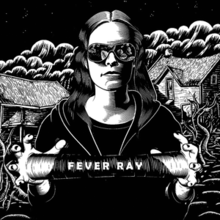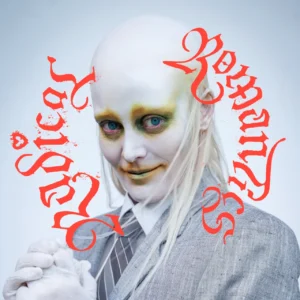In the sprawling world of electronic music, where genres blur and boundaries break, Fever Ray stands as an enigmatic force — a haunting voice that lingers, reshaping the landscape with every release. Fever Ray, the solo project of Swedish musician Karin Dreijer, is known for a sound that’s as arresting as it is unsettling. Dreijer, who first gained international acclaim as one half of the avant-garde electronic duo The Knife, carved out a distinct solo identity under Fever Ray. Here, the familiar edgy production and cerebral lyrics merge with an even darker, more intimate atmosphere.
With their music, Fever Ray creates an experience that’s not just auditory but sensory and often surreal. Dreijer’s voice, manipulated and layered, shifts between haunting whispers and primal cries, channeling the depths of human emotion with chilling precision. And it’s not just the voice or the lyrics that captivate; it’s the immersive, boundary-pushing soundscapes that make Fever Ray a magnetic presence in the electronic and experimental music scenes. Combining raw vulnerability with cryptic storytelling, Fever Ray challenges traditional expectations and crafts a visceral exploration of identity, love, and the human psyche.
Background
Early Life
Karin Dreijer, the mind behind Fever Ray, was born in Gothenburg, Sweden, in 1975. Growing up in a small city where music was a refuge from the everyday, Dreijer showed an early fascination with the abstract and unusual. Gothenburg, a port city with a complex mix of industrial grit and Scandinavian beauty, exposed Dreijer to diverse sounds, from traditional Swedish folk to the budding post-punk and electronic scenes sweeping across Europe. Dreijer’s early interest in storytelling, mythology, and cinema would shape their future artistic vision, blending imagination with a desire to push beyond the expected.
As a queer artist in a society with well-defined cultural norms, Dreijer grew up with a strong sense of individuality, finding ways to express themselves outside conventional frameworks. They gravitated toward art that captured the emotional and the unconventional — a style that would later form the bedrock of Fever Ray’s music and visual language.
Musical Beginnings
Dreijer’s path to music began in the early ’90s when they co-founded the indie rock band Honey Is Cool, where they served as lead vocalist and guitarist. The group gained a modest following in Sweden, mixing rock with experimental sounds and giving Dreijer the first taste of creating within an avant-garde framework. It was during this time that Dreijer started using vocal effects to manipulate their voice, a practice that would become a Fever Ray trademark. Dreijer’s experimentation with vocal techniques hinted at an interest in breaking down the familiar aspects of gender and identity, themes that would become central to their work in later years.
Honey Is Cool disbanded in 2000, but Dreijer was already on a new path. Teaming up with their brother Olof Dreijer, they formed The Knife, a project that would elevate both siblings to global prominence. The Knife became a defining act of the 2000s electronic scene, known for its politically charged lyrics, innovative production, and mysterious public image. From “Silent Shout” to “Deep Cuts,” the duo’s music was daringly experimental, blending dark synths, unconventional melodies, and biting social commentary. The Knife was the crucible where Dreijer refined their skill as both a vocalist and producer, and it was through this project that Dreijer began to define their distinctive approach to music.
Artistic Influences
Fever Ray’s sound is influenced by an eclectic mix of artists and genres, from the dark and ambient tones of Björk and Aphex Twin to the ritualistic undertones of traditional folk music. Dreijer’s fascination with the eerie and otherworldly stems in part from Swedish folklore, as well as from experimental theater and visual art. Dreijer’s use of unconventional sounds, such as distorted breaths and eerie silence, calls to mind the influence of pioneers in electronic music and sound design like Brian Eno and Kraftwerk. There’s a theatricality in Dreijer’s work that also evokes influences from performance art and horror cinema, creating a cinematic quality to Fever Ray’s music that transports listeners to an immersive, often surreal world.
Politically and artistically, Dreijer has cited the influence of queer and feminist artists and activists. This perspective is woven into Fever Ray’s work, challenging norms surrounding gender, identity, and society’s expectations. Dreijer’s synthesis of political consciousness with emotional vulnerability makes their music resonate on both an intellectual and visceral level, blending electronic, punk, and experimental elements to forge a sound that defies genre — at once both confrontational and hauntingly intimate. Fever Ray is, ultimately, a reflection of Dreijer’s lifelong pursuit to create music that doesn’t just tell a story but invites listeners to explore what lies beneath the surface of the familiar.
Album Overviews
Fever Ray (2009)

Fever Ray’s self-titled debut, released in 2009, was a startling solo introduction for Karin Dreijer, immediately setting Fever Ray apart from Dreijer’s work with The Knife. The album features eerie, stripped-down electronic landscapes and showcases Dreijer’s distinct vocal manipulations. Tracks like “If I Had a Heart” and “When I Grow Up” blend dark, pulsating synths with cryptic lyrics, conjuring a sense of ritualistic mystery.
The production is minimalist but intensely atmospheric, exploring themes of isolation, domesticity, and longing. “If I Had a Heart,” which has since become iconic through film and television soundtracks, reveals Dreijer’s ability to capture deep emotion with sparse lyrics and unsettling textures. Fever Ray was highly acclaimed for its brooding, otherworldly aesthetic, carving a space in electronic music for Dreijer’s unique voice and unflinching explorations of identity and desire.
Plunge (2017)

Eight years after the debut, Plunge arrived with a distinctly more aggressive and colorful sound. Released in 2017, the album marks a sonic and thematic shift for Fever Ray, with brighter tempos, more explicit lyrics, and a fierce political stance. While the debut was introspective and shadowed, Plunge is audacious and direct, exploring sexuality, queerness, and resistance with a newfound urgency. Tracks like “To the Moon and Back” and “IDK About You” feature propulsive beats, raw synths, and Dreijer’s most provocative lyrics to date, celebrating queer desire and challenging societal norms.
The album captures Dreijer’s growing comfort in their identity, showcasing bold, unfiltered messages wrapped in danceable beats. Thematically, Plunge delves into the politics of pleasure and power, reflecting Dreijer’s desire to confront and question taboos openly. Sonically and visually, it’s a colorful, feverish whirlwind that cemented Fever Ray’s reputation for challenging boundaries both musically and thematically.
Radical Romantics (2023)

Released in 2023, Radical Romantics sees Fever Ray exploring love, intimacy, and connection through a complex lens. Blending the dark intimacy of Fever Ray with the energetic edge of Plunge, this album balances introspective and confrontational elements. Dreijer co-produced the album with long-time collaborator Olof Dreijer, marking the first significant collaboration with their brother since The Knife disbanded. Tracks like “What They Call Us” and “Carbon Dioxide” showcase a more refined but no less intense approach to Fever Ray’s characteristic sound — haunting melodies, immersive production, and poetic lyrics.
Thematically, Radical Romantics contemplates love as both beautiful and fraught, rejecting simplistic portrayals of romance in favor of exploring its many contradictions. The album reflects Dreijer’s evolution as an artist, blending the familiar with the experimental and showing a nuanced understanding of the complexities of love, identity, and self-expression.
Industry Perspective
Challenges and Triumphs
Throughout their career, Karin Dreijer has navigated the complexities of fame while maintaining a steadfast commitment to their artistic integrity. One of the most significant hurdles Dreijer has faced is balancing widespread popularity with an aversion to public scrutiny. Their journey began with The Knife, a project in which both Dreijer siblings maintained a famously elusive persona, performing in masks and avoiding mainstream media to resist the industry’s pressures and protect their creative freedom. As Fever Ray, Dreijer continued to grapple with the tension between public visibility and personal privacy, crafting an anonymous, even alien-like persona that allowed them to explore deeply personal themes while remaining partially concealed.
Beyond privacy, Dreijer has also confronted challenges related to gender, identity, and queerness in a music industry often resistant to genuine individuality. Dreijer’s willingness to defy traditional gender roles — through both vocal distortions and performative aesthetics — has been an empowering statement but one that comes with risks of misunderstanding or rejection. Yet, each release has marked a triumph of authenticity over conformity, gaining Dreijer a loyal, appreciative audience while also paving the way for nonbinary and queer artists across genres. Fever Ray’s work breaks down barriers for future generations, creating more space within electronic music for expression that is raw, complex, and unbound by convention.
Collaborations and Connections
Collaboration has been integral to Dreijer’s work, and Fever Ray’s music is enriched by a variety of partnerships and collective efforts. The most significant of these connections is, of course, with Dreijer’s brother Olof Dreijer, with whom they formed The Knife. Though Fever Ray was initially a solo venture, Olof’s return as a collaborator on Radical Romantics in 2023 added a familiar, yet evolved dynamic that brings the project full circle. This reunion didn’t just echo The Knife’s era but also allowed both artists to explore new facets of their creative chemistry, drawing on nearly two decades of shared innovation.
In addition to family collaborations, Dreijer has worked with several notable figures in the electronic and experimental music worlds. Plunge, for instance, saw collaborations with producers like Portuguese DJ Nídia and British electronic artist Paula Temple, whose styles brought a harder, more rhythmic edge to Fever Ray’s sound. These collaborations injected Plunge with a sense of movement and energy, pushing Dreijer’s music into new territory by fusing Fever Ray’s introspective lyrics with club-ready beats and sounds.
Through these partnerships, Dreijer connects with an international community of experimental and electronic musicians, forming a network that supports innovation across borders. This spirit of collaboration is central to Dreijer’s ethos, bringing a rich diversity of influence into Fever Ray’s work and pushing Dreijer to continuously expand their sonic landscape.
Recognition and Achievements
Over the years, Fever Ray has gained both critical and popular acclaim, reaching far beyond the niche audiences typical for experimental music. The self-titled debut album was met with overwhelmingly positive reviews, landing on numerous “Best of” lists for its haunting production and genre-defying aesthetic. “If I Had a Heart,” the lead single, became a defining moment for Fever Ray, featuring in prominent TV shows like Vikings, which helped it reach a broader audience and solidify Fever Ray’s presence in pop culture.
Plunge received even greater critical attention, including a nomination for Best Dance/Electronic Album at the Grammy Awards, a significant recognition for an artist whose sound defies typical radio play appeal. The album’s radical celebration of queer desire resonated widely, establishing Fever Ray as an influential voice in LGBTQ+ circles and drawing praise for its unapologetic approach to pleasure and autonomy.
Dreijer’s influence in the industry also extends beyond awards and critical acclaim; Fever Ray is regarded as a pioneering force within electronic and experimental music. Each Fever Ray release garners a strong following, and the artist is consistently celebrated for their bold, genre-defying work, setting an example for musicians who seek to challenge the norms and embrace the surreal. Fever Ray’s influence is felt far and wide, from art-pop and electronic music to contemporary queer and feminist discourse, solidifying Dreijer’s legacy as an artist who, by following their own vision, has carved a path that is as influential as it is inimitable.
Impact and Legacy
Cultural Significance
Fever Ray has become a touchstone in the world of electronic and experimental music, embodying a rare synthesis of artistry, social critique, and raw emotion. In an industry often dominated by image-driven pop, Fever Ray stands out as a defiant, nonconformist presence, challenging the boundaries of gender, genre, and identity in music. Fever Ray’s exploration of queerness and selfhood, conveyed through the eerie landscapes of their music and the ambiguity of their vocal manipulations, has significantly impacted not only electronic music but also the broader cultural dialogue on gender and representation.
By rejecting conventional gender expressions and embracing a theatrical, surreal aesthetic, Fever Ray has influenced a generation of artists willing to explore similar themes, from Arca and Sophie to FKA twigs. Dreijer’s work helps redefine what it means to be “seen” as an artist, showing that visibility can be more about ideas and emotions than physical image or identity.
The impact of Fever Ray’s work is also evident in their contribution to the resurgence of dark, synth-based sounds, popularized in part by their 2009 debut. This album arrived as a cultural statement, blending elements of post-punk, ambient, and electronic music to create a sound that felt both intimate and apocalyptic, resonating with listeners drawn to music that expressed existential fears and complex emotional landscapes. In doing so, Fever Ray has solidified a new space within electronic music, one where vulnerability, authenticity, and political awareness flourish, pushing listeners and artists alike to embrace the strange and the subversive.
Fanbase and Community
Fever Ray’s fans are as dedicated as they are diverse, drawn to the artist’s bold defiance of norms and the emotional resonance of their music. The fan community around Fever Ray reflects a shared love for the unconventional, with fans often dressing up in theatrical costumes inspired by the artist’s iconic, surreal visuals for concerts and events. This fan-driven artistry mirrors the themes in Fever Ray’s work, emphasizing freedom of expression, boundary-breaking aesthetics, and an appreciation for the unusual. Fever Ray’s online fanbase, though global, often connects over common themes of queerness, empowerment, and social consciousness, creating a supportive network that reflects the values inherent in Dreijer’s music.
Fever Ray’s relationship with fans is fueled by this sense of kinship, strengthened by Dreijer’s openness about their journey through identity and self-discovery. Fans resonate with Dreijer’s exploration of topics often left on the margins of mainstream music, such as queerness, fluidity, and resistance, creating a collective understanding that extends beyond traditional fan-artist boundaries. Dreijer’s work allows fans to reflect and redefine their own identities, resulting in a fanbase that sees Fever Ray as more than a musical project — but rather as a space for exploration, healing, and self-acceptance.
Looking Forward
As Fever Ray continues to evolve, the project is likely to explore new sonic and thematic territories, pushing deeper into uncharted artistic ground. Dreijer’s reunion with Olof on Radical Romantics suggests the potential for continued collaboration, blending the best of The Knife’s experimental spirit with the mature, introspective lens of Fever Ray. There is a sense that Fever Ray may continue to move further into examining personal and political complexities around love, vulnerability, and connection, evolving with the times while maintaining the avant-garde roots that define their sound.
Long-term, Fever Ray’s legacy in music seems set in stone as a pioneer of boundary-breaking electronic music and a champion of queer and feminist expression. They have already paved the way for future generations of artists who see their identity as integral to their artistry, and their impact on electronic and experimental music will only deepen over time. Fever Ray’s continued influence on both niche and mainstream music underscores Dreijer’s lasting contribution to the cultural landscape, showing that true originality is timeless.
As Fever Ray’s career progresses, Dreijer’s work promises to leave an indelible mark on electronic music, not only as a musical innovator but as an artist unafraid to confront, challenge, and redefine what it means to be human in a changing world.
